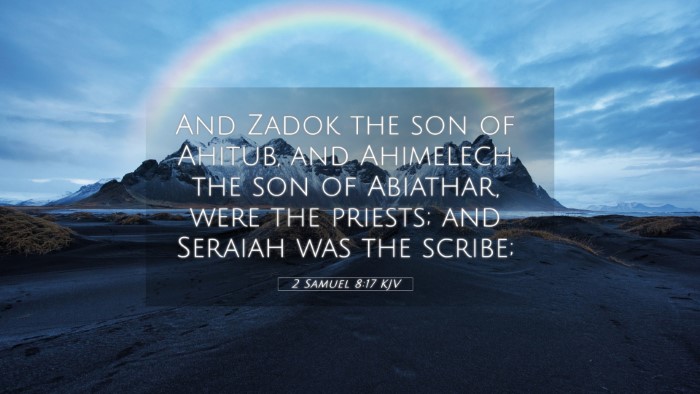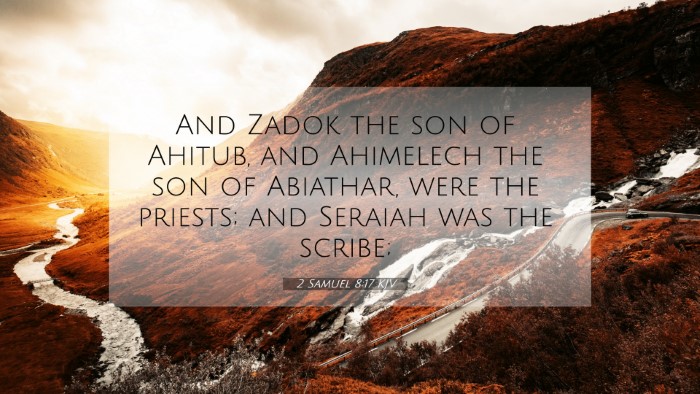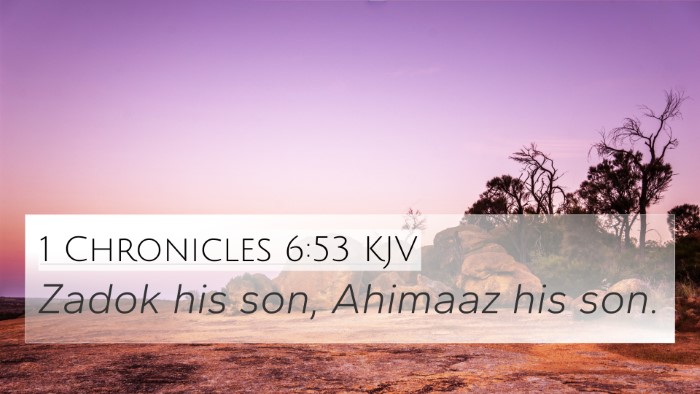Old Testament
Genesis Exodus Leviticus Numbers Deuteronomy Joshua Judges Ruth 1 Samuel 2 Samuel 1 Kings 2 Kings 1 Chronicles 2 Chronicles Ezra Nehemiah Esther Job Psalms Proverbs Ecclesiastes Song of Solomon Isaiah Jeremiah Lamentations Ezekiel Daniel Hosea Joel Amos Obadiah Jonah Micah Nahum Habakkuk Zephaniah Haggai Zechariah Malachi2 Samuel 8:17 Similar Verses
2 Samuel 8:17 Cross References
And Zadok the son of Ahitub, and Ahimelech the son of Abiathar, were the priests; and Seraiah was the scribe;
Uncover the Rich Themes and Topics of This Bible Verse
Listed below are the Bible themes associated with 2 Samuel 8:17. We invite you to explore each theme to gain deeper insights into the Scriptures.
2 Samuel 8:17 Cross Reference Verses
This section features a detailed cross-reference designed to enrich your understanding of the Scriptures. Below, you will find carefully selected verses that echo the themes and teachings related to 2 Samuel 8:17 KJV. Click on any image to explore detailed analyses of related Bible verses and uncover deeper theological insights.
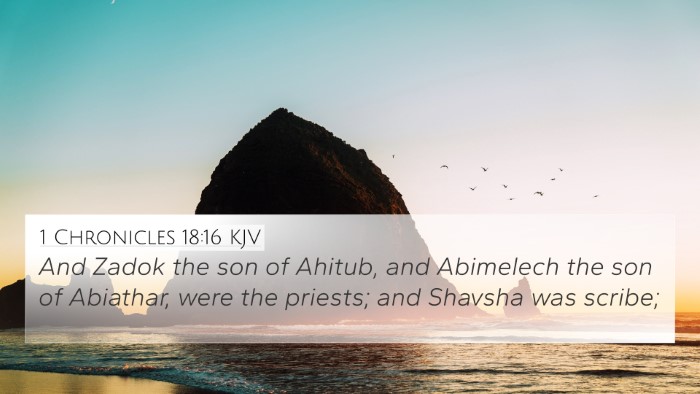
1 Chronicles 18:16 (KJV) »
And Zadok the son of Ahitub, and Abimelech the son of Abiathar, were the priests; and Shavsha was scribe;
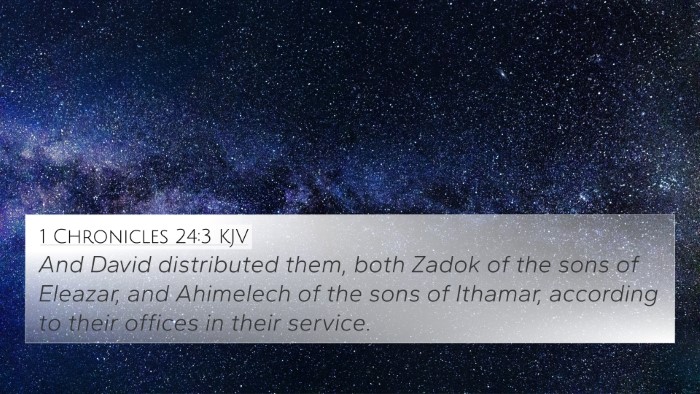
1 Chronicles 24:3 (KJV) »
And David distributed them, both Zadok of the sons of Eleazar, and Ahimelech of the sons of Ithamar, according to their offices in their service.
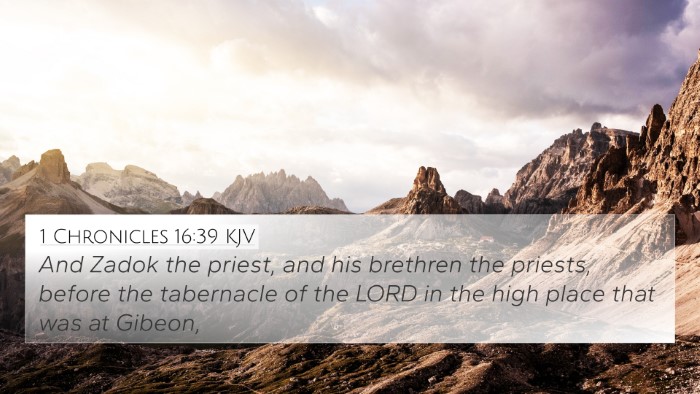
1 Chronicles 16:39 (KJV) »
And Zadok the priest, and his brethren the priests, before the tabernacle of the LORD in the high place that was at Gibeon,
2 Samuel 8:17 Verse Analysis and Similar Verses
Understanding 2 Samuel 8:17
Verse: 2 Samuel 8:17: "And Zadok the son of Ahitub, and Ahimelech the son of Abiathar, were the priests; and Seraiah was the scribe."
Overview
This verse highlights key figures in King David's administration, specifically mentioning priests and a scribe, indicating the organization and structure of leadership during his reign. The significance of these roles provides insight into the religious and governmental framework of ancient Israel.
Key Concepts
- Religious Structure: The presence of priests underscores the importance of the Levitical priesthood in Israel's religious practices.
- Administrative Order: Featuring a scribe indicates the necessity for record-keeping and governance in a burgeoning monarchy.
Commentary Insights
Matthew Henry: Henry emphasizes the importance of Zadok and Abiathar, linking their priestly roles to the spiritual well-being of the nation. He notes that Zadok remained steadfast in his loyalty to David, contrasting with others who turned against him.
Albert Barnes: Barnes speaks to the significance of having both Zadok and Abiathar as the priests, suggesting a representation of two distinct priestly lines. He highlights their role in maintaining the covenantal relationship between God and the people, thereby emphasizing the spiritual authority present in David's court.
Adam Clarke: Clarke comments on Seraiah as the scribe, indicating the importance of written records in the governance of David's kingdom. He notes that scribes played a critical role in legal matters and the administration of justice, contextualizing their significance in ancient Israel.
Bible Verse Cross-References
This verse relates to various other scriptures that highlight themes of leadership, priesthood, and governance:
- 1 Chronicles 24:3: Details the divisions of the priesthood, linking back to the roles of Zadok and Abiathar.
- Exodus 28:1: Discusses the appointment of priests, providing background on their significance.
- Hebrews 7:11-14: Relates to the priestly order, contrasting with the order of Melchizedek.
- 2 Samuel 15:24-29: Provides context for the conflict during Absalom's rebellion and the loyalty of the priests.
- Jeremiah 1:18: References a scribe's role in speaking for God, connecting to Seraiah's administrative importance.
- 1 Samuel 22:20-23: Discusses Abiathar's escape and significance as a priest during King Saul’s reign.
- 2 Kings 11:4: Connects to the theme of priestly influence during significant political events in Israel.
Thematic Connections
The verse's focus on leadership resonates through various themes in Scripture:
- Divine Authority: The anointing of priests represents God's authority over His chosen people.
- Covenantal Leadership: The roles assigned here reflect the covenantal nature of God's relationship with Israel.
Applying Cross-Referencing
Cross-referencing biblical texts enriches our understanding of Scripture. It encourages:
- Exploration of the inter-Biblical dialogue between the Old and New Testaments.
- Identifying thematic connections, such as those between priestly duties and apostolic teachings.
- Studying the implications of leadership roles throughout the narrative of the Bible.
Implementing Tools for Bible Cross-Referencing
Using resources such as a Bible concordance or a cross-reference guide aids in:
- Finding parallels between related scriptures.
- Conducting a comparative Bible verse analysis.
- Preparing sermons and teachings through carefully chosen bible verse connections.
Conclusion
In summary, 2 Samuel 8:17 encapsulates crucial elements of leadership, governance, and worship in ancient Israel, illustrating the intertwining of spiritual and civil authority. The analysis of its themes and connections to other scriptures provides a deeper understanding of God’s orchestration in the life of His people.

